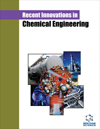- Home
- A-Z Publications
- Recent Innovations in Chemical Engineering (Formerly Recent Patents on Chemical Engineering)
- Previous Issues
- Volume 9, Issue 2, 2016
Recent Innovations in Chemical Engineering (Formerly Recent Patents on Chemical Engineering) - Volume 9, Issue 2, 2016
Volume 9, Issue 2, 2016
-
-
From Terrestrial and Marine Bioresources and Wastes to Value- Added Products: Biofuels and Activated Carbons
More LessAuthors: Mohamed Chaker Ncibi and Mika SillanpaaBackground: The bioconversion of renewable terrestrial and marine bioresources and agro-industrial wastes presents a very interesting research and development (R) subject to show how high added-value products could be obtained from inexpensive materials, and how this bioconversion could bring solutions to many serious problems like fuel shortage, pollution and waste disposal in a sustainable, yet profitable manner. O Read More
-
-
-
Pour Point Depressant for Waxy Crude Oil: A Mini-Review
More LessAuthors: Guolin Jing, Ping Ye and Yanli ZhangBackground: The background of using the pour point depressant is that wax precipitation causes several challenges during oil extraction and pipeline transport of waxy crude oils, including wax deposition, plugging of the pipeline and damage to the oil drilling equipment, which, collectively, adversely impacts pipeline performance. Method: The method which used to solve the problem of paraffin deposit is adding chemical ad Read More
-
-
-
A Mini-Review of Photo Catalytic Process in Wastewater Treatment
More LessAuthors: A. Nouri, A. Hedayati Moghaddam and J. SargolzaeiIntroduction: In recent years many investigations have been accomplished in the field of photocatalysis for decomposition of organic matters and other pollutants in order to achieve stringent discharge standards. Therefore, making an assessment on the wastewater treatment processes through photocatalytic reactors seems to be an interesting option. Objective: In this study, we discussed the various methods and patent Read More
-
-
-
Preparation of MnOx Loaded Activated Carbon for SO2 Removal by Redox Deposition
More LessAuthors: Tian Huang, Jun Mei and Hao LiuMn0x particles were successfully in situ doped on activated carbon via a redox deposition process. The effects of calcination temperature on the surface characteristics and desulfurization performance were studied. Desulfurization activity was evaluated at a fixed bed reactor in simulated flue gas. A remarkable promotional effect was observed by supporting Mn0 particles on activated carbon surface. Results showed that the s Read More
-
-
-
Utilization of Microalgae Cultivated in Palm Oil Mill Wastewater to Produce Lipid and Carbohydrate by Employing Microwave- Assisted Irradiation
More LessAuthors: M. M. Azimatun Nur, Dedy Kristanto, Tutik Muji Setyoningrum and I.G.S BudiamanBackground: Palm oil mill effluent (POME) is dominant agroindustrial wastewater in Indonesia and Malaysia. Some kind of microalgae can utilize the wastewater as media of cultivation, and produce value-added compounds. However, the production of lipid and carbohydrate from microalgae cultivated on untreated POME medium were not clearly reported. Objective: to cultivate Chlorella vulgaris, Dunaliella salina, and Spirulin Read More
-
-
-
Optimization of Diesel Oil Biodegradation by Response Surface Methodology and Immobilization Technique
More LessAuthors: Yunduo Liu, Jingwei Ren, Ruidan Xu, Jian Wang and Jianghong LiuBackground: As a kind of hydrocarbon mixtures, diesel oil is mainly consisted of linear chain alkanes as a medium distillate of petroleum. The removal of diesel oil depends on several technologies not merely chemical or physical, but also biological methods, especially biodegradation. Method: Five microorganisms considered as the potential diesel oil-degrading bacteria were chosen for biodegradation experiment. Am Read More
-
-
-
Thermodynamic Analysis of Sub and Supercritical Water Gasification of Aqueous Fraction of Hydrothermal Liquefaction of Biomass for Production of Hydrogen Rich Bio-Gas
More LessAuthors: Rakesh Kumar, Sasanka Raha, Supriya S. Apegaonkar and Ramesh BhujadeBackground: The Hydrothermal liquefaction (HTL) of the biomass generates two phases, namely, liquid bio crude & an aqueous phase containing soluble hydrocarbons. Hydrothermal gasification converts aqueous hydrocarbons into fuel gas containing mainly CH4,H2 and CO2. Objective: Objective of the present study is to carry out thermodynamic analysis of sub and supercritical water gasification of aqueous fraction of Read More
-
Most Read This Month
Article
content/journals/rice
Journal
10
5
false
en


